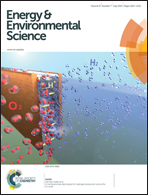High-performance silicon-based multicomponent battery anodes produced via synergistic coupling of multifunctional coating layers†
Abstract
Nanostructured Si-based materials are key building blocks for next-generation energy storage devices. To meet the requirements of practical energy storage devices, Si-based materials should exhibit high-power, low volume change, and high tap density. So far, there have been no reliable materials reported satisfying all of these requirements. Here, we report a novel Si-based multicomponent design, in which the Si core is covered with multifunctional shell layers. The synergistic coupling of Si with the multifunctional shell provides vital clues for satisfying all Si anode requirements for practical batteries. The Si-based multicomponent anode delivers a high capacity of ∼1000 mA h g−1, a highly stable cycling retention (∼65% after 1000 cycles at 1 C), an excellent rate capability (∼800 mA h g−1 at 10 C), and a remarkably suppressed volume expansion (12% after 100 cycles). Our synthetic process is simple, low-cost, and safe, facilitating new methods for developing electrode materials for practical energy storage.


 Please wait while we load your content...
Please wait while we load your content...